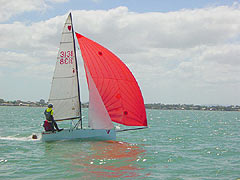
Cherub sailing dinghy
The Cherub dinghy is a doublehanded 12-foot racing dinghy with asymmetric spinnaker and twin trapezes. The history of the Cherub sailing dinghy starts in 1951 when John Spencer designed a 12 foot cruising dinghy for a Mr. Ray Early to sail round the Auckland Area in New Zealand. When asked what their new boat was, his wife said “I don’t know, but she’s a perfect little cherub to Sail”. The Cherub Class was introduced to the UK in the 1956 when boats were built by McCutcheon’s of Cowes.
Early Cherubs had appreciably less sail area than modern ones, with stated dimensions of 62 sq.ft. for the mainsail, 27sq. ft for the jib, and 60sq.ft spinnaker. The spinnaker was particularly unusual, since it was typically a virtually flat triangular sail with wire luffs, which could be carried with the true wind forward of the beam. This sail, set from a spinnaker pole that could be 9 ft long, resulted in spectacular close reaching performance, but was rather less effective on a run.
The Cherub Class is a Development Class. This means you have a set of rules that boats are designed within. This lets you create or modify a boat the way you like it, not the way a manufacturer sets it up. In general the boats last longer, because they can be changed to keep up to speed with current sailing development without getting a new boat too often. They also tend to be made in a more sophisticated manner, using carbon or glass foam sandwich techniques, making them stiffer and lighter than conventional sailing dinghies.
After more than half a century the Cherub dinghy still stands out. The Cherub is the lightest doublehander sailed in Britain. The weight is far less than any of the single manufacturer one-designs (and has been since 1951!). The Cherub sailing dinghy suits a lower crew weight than any other twin trapeze boat.
Cherubs are really quick offwind and have an excellent power to weight ratio and not too much wetted surface. Video footage has shown Cherubs hitting 25 knots, which is pretty fair by anyone’s standards. Even more important than the raw speed is the handling. Ultra light, ultra responsive, ultra quick.
Length : 3.7m
Beam : 1.8m
Weight : 50kg
Sail Area : 36.50m sq
